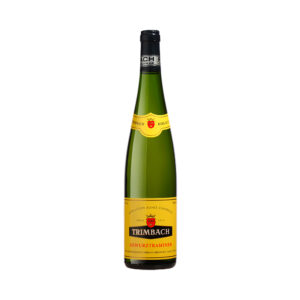
I’ll never forget the first time I tasted Gewürztraminer wine. I was at a small, cozy dinner party with friends, and someone brought out this beautiful bottle with a name I could barely pronounce.
I remember being amused by the fact that the wine smelled like a bouquet of roses and lychees, but the real surprise came when I took that first sip. It was like a little firework of flavors—spicy, sweet, and so intensely aromatic that it made me pause and really savor it.
I’ve always had a soft spot for drinks with a bit of a kick, but Gewürztraminer felt like it was made just for me. The way it dances between sweetness and spice is simply unforgettable. Ever since then, it’s been my go-to when I want to impress guests or treat myself to something special.
If you’re a wine lover who enjoys bold flavors and unique aromas, Gewürztraminer might just be your new favorite grape. This guide will walk you through everything you need to know about this delicious wine.
What is Gewürztraminer?
Gewurztraminer pronunciation isn’t as hard as it looks; it’s pronounced “guh-voorts-trah-mee-ner”. It’s a white wine grape variety known for its distinctive and aromatic profile. The name “Gewürztraminer” translates to “spiced traminer,” which hints at its flavor profile.
These wines are incredibly versatile, ranging from dry to sweet, making them suitable for a variety of occasions and dishes. Dry versions tend to have a more refined, crisp character with bold floral and spice aromas, paired with a light, fruity flavor, but with a cleaner, refreshing finish that doesn’t overwhelm the palate.
On the other hand, sweeter ones offer a richer, more luxurious experience. They are often celebrated for their bold, fruity character and luscious sweetness. Noble rot (Botrytis cinerea) is especially important in creating some of the sweetest Gewürztraminer wines.
This naturally occurring fungus dehydrates the grapes, concentrating their sugars and flavors while adding a unique honeyed character. Wines affected by noble rot have more intense sweetness and complexity, making it perfect for those who love a dessert-style Gewürztraminer.

Where Does Gewürztraminer Come From?
It’s easy to assume that Gewurztraminer wine hails from Germany, given its complex name and the fact that Germany is famous for its white wines. But here’s the twist: Gewürztraminer literally means “the spicy wine from Tramin”.
Its roots actually trace back to a small, mainly German-speaking town of Tramin in northern Italy, where the grape variety first flourished. The name itself is a combination of “Gewürz,” which is German for spice or aromatic, and “Traminer,” referring to its place of origin, Tramin.
Notable Gewürztraminer Regions
Over time, the grape spread to various wine regions across the globe, each contributing its unique touch to the wine’s profile. Here are some of the most notable regions:
- Alsace, France: This region is arguably the most famous for Gewürztraminer. The cool climate and diverse soil types in Alsace help produce some of the most aromatic and full-bodied Gewürztraminer wines.
- Germany: In Germany, particularly in the Pfalz and Rheinhessen regions, Gewürztraminer is often produced in a sweeter style, sometimes labeled as Spätlese or Auslese.
- Italy’s Alto Adige (AKA Sudtirol): As the birthplace of the gewurztraminer grape, this region produces wines with a slightly more restrained aromatic profile, focusing on minerality and acidity.
- New Zealand: In the Marlborough region, it is crafted with a focus on freshness and vibrant tropical fruit flavors.
- California, USA: In places like Sonoma and Mendocino, the wine is made in both dry and off-dry styles, often showcasing bold fruit flavors and a crisp finish.

Gewürztraminer Taste
The taste of Gewürztraminer is as bold and unique as its aroma. Here’s what you can typically expect when you take a sip:
- Lychee: The most iconic flavor associated with Gewürztraminer, offering a sweet and exotic fruitiness.
- Rose Petals: Floral notes are a hallmark of this wine, adding a delicate, aromatic layer.
- Tropical Fruit: Think mango, pineapple, and passion fruit—these flavors bring a vibrant, juicy quality.
- Spice: Hints of cinnamon, ginger, and allspice often dance around in the background, contributing to the wine’s complexity.
- Honey: In sweeter styles, you might notice a rich honeyed finish, especially in dessert wines.
This grape is similar to a spicy Pinot Gris.

Gewürztraminer Food Pairings
Gewürztraminer pairs well with a wide range of food categories due to its aromatic, slightly spicy, and often sweet flavor profile. Here are some ideal food pairings:
- Spicy Dishes – Dishes like Indian curries, Thai food, or Mexican cuisine are perfect. Sweet styles especially balance out the heat and spices perfectly.
- Savory Meats – It works well with roast pork, duck, and sausages. The wine’s bold flavors complement the richness of the meats.
- Strong Cheeses – Blue cheese, aged cheddar, or pungent cheeses like Munster or Brie. Gewürztraminer’s sweetness and acidity cut through the boldness of the cheese.
- Asian Cuisine – Foods with soy sauce, ginger, or even sushi find a good match in Gewürztraminer, which enhances those umami flavors.
- Fruity Desserts – Tarts, pies, or any fruit-based desserts (especially with lychee or peaches) are elevated by the wine’s tropical fruit notes.
Fun Facts
Gewürztraminer is more than just a delicious wine—it’s got a few interesting quirks too:
- Sensitive Grape: The grapes are notoriously difficult to grow. They’re highly sensitive to climate and soil, making them a challenge for winemakers.
- Noble Rot: In regions like Alsace, Gewürztraminer grapes can be affected by “noble rot,” which concentrates the sugars and flavors, leading to sweet, intense wines like Vendange Tardives and Sélection de Grains Nobles.
- Rose-Scented: Some of the wine’s signature aromas come from terpenes, the same compounds found in roses and other aromatic plants.
When is Gewürztraminer Day?
Gewürztraminer Day is celebrated on November 21st each year. It’s the perfect excuse to open a bottle and enjoy the unique flavors of this aromatic wine. To be up to date on all the Wine Holidays, check out the Annual Wine Holiday Calendar.
Six Best Gewürztraminer Wines to Try
Here are five of the best Gewürztraminer wines that I love and you should definitely try:

Gundlach Bundschu
My absolute favorite Gewürztraminer wine! It’s particularly delicious when paired with Asian cuisine (even simple stuff, like Panda Express’s orange chicken). The wine’s tropical fruit notes and slight sweetness complement the bold flavors of the dish perfectly.
Typically $30
Buy It Here

Ulloa Cellars
This woman-made wine from Paso Robles is as unique as it is delicious. The winemaker pairs her wines with crystals, adding a touch of spirituality to the drinking experience. The wine itself is beautifully balanced, with just the right amount of sweetness and spice.
Typically $38
Buy it Here

Pfeffingen Ungsteiner Gewürztraminer Spätlese
A great example of a German Gewürztraminer, this wine is on the sweeter side and is a testament to the quality of German winemaking. I love everything this producer makes, and this bottle is no exception.
Typically $30
Buy it Here
Typically $11
Shop on Wine.com

Chateau Ste. Michelle
This lightly sweet Gewürztraminer was one of my gateway wines when I first started exploring the world of wine. It’s approachable, with just enough sweetness to make it easy to love, even for wine newbies.
Typically $11
Buy it Here

Trimbach Gewürztraminer
If you’re looking for a great giftable bottle, this is it. A classic example from Alsace, France, Trimbach’s Gewürztraminer is refined, aromatic, and always a crowd-pleaser.
Typically $32
Buy it Here

Clif Family
Clif Family is one of my favorite Napa wineries and makes an incredible Gewurztraminer wine with fruit from Mendocino Country. It’s dry, refreshing, and oh-so flavorful. A glass of this is perfect on a hot summer day!
Typically $32
Buy it Here
Conclusion
Gewürztraminer is a wine that’s hard to forget. Its bold, aromatic profile offers something for everyone, whether you prefer your wine sweet, dry, or somewhere in between. From pairing with spicy dishes to complementing rich cheeses, it’s a wine that can elevate many culinary experiences.
If you haven’t yet explored this delightfully tasty wine, now is the perfect time to start. It’s a wine that invites curiosity and rewards those willing to try something different. Consider reaching for Gewürztraminer next time you’re in the mood for wine—you might just find a new favorite.
Frequently Asked Questions
- How do you pronounce Gewürztraminer?
Gewürztraminer is pronounced “guh-voorts-trah-mee-ner.” It might be tricky at first, but it rolls off the tongue after a few tries. - Is Gewürztraminer always sweet?
No, Gewürztraminer can range from dry to sweet, depending on how it’s made. While some versions are sweet, others can be quite dry and spicy. - What foods pair best with Gewürztraminer?
Gewürztraminer pairs well with spicy Asian dishes, smoked meats, aged cheeses, roasted duck, and fruit desserts. Its bold flavors make it a versatile wine for food pairing - How should Gewürztraminer be served?
Gewürztraminer is best served chilled, around 45–50°F (7–10°C). This temperature helps bring out its complex aromas and refreshing acidity.
